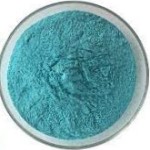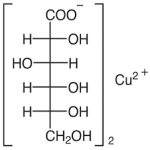CAS Number 527-09-3, Copper Gluconate USP FCC Food Grade Manufacturers Exporters







CAS Number 527-09-3, Copper Gluconate Manufacturer Exporter
For Properties Specifications of Copper Gluconate Click Properties, Specifications of Copper Gluconate Manufacturer.
For Uses of Copper Gluconate Click Uses of Copper Gluconate Manufacturer.
For For SDS MSDS Sheet of Copper Gluconate Click SDS Safety Data Sheet MSDS Sheet of Copper Gluconate Manufacturer.
The Properties and Specifications of Copper Gluconate:
Copper Gluconate USP Grade Specifications
C12H22CuO14 --- 453.84
Copper, bis(D-gluconato-O1,O2)-.
Copper D-gluconate (1:2) CAS 527-09-3
Copper Gluconate contains not less than 98.0 percent and not more than 102.0 percent of C12H22CuO14.
Identification—
A: A solution (1 in 20) responds to the test for Copper.
B: Chromatographic plate test.
Chloride: A 1.0-g portion shows no more chloride than corresponds to 1 mL of 0.020 N hydrochloric acid (0.07%).
Sulfate: A 2.0-g portion dissolved in boiling water shows no more sulfate than corresponds to 1 mL of 0.020 N sulfuric acid (0.05%).
Arsenic: the limit is 3 ppm.
Lead: the limit is 0.0025%.
Reducing substances: the limit is 1.0%.
Copper Gluconate FCC Food Grade Specifications
[CH2OH(CHOH)4COO]2Cu
C12H22CuO14 Formula weight 453.84
CAS 527-09-3
DESCRIPTION
Copper Gluconate occurs as a fine, light blue powder. It is very soluble in water, and is very slightly soluble in alcohol.
Function: Nutrient.
REQUIREMENTS
Identification:
A. A 1:20 aqueous solution gives positive tests for Copper.
B. Chromatographic test.
Assay: Not less than 98.0% and not more than 102.0% of C12H22CuO14.
Lead: Not more than 5 mg/kg.
Reducing Substances: Not more than 1.0%.
The Uses of Copper Gluconate:
Copper Gluconate is used as a nutrient or dietary supplement and is generally recognized as safe for use at a level not exceeding 0.005 percent. It is Dietary supplement to treat copper deficiency. Copper gluconate, the copper salt of gluconic acid, is an ingredient that delivers the important trace element copper to the skin.
The MSDS-SDS Hazard Statement of Copper Gluconate:
Copper Gluconate SDS, Safety Data Sheet
MSDS Sheet, Material Safety Data Sheet 10-Jan-23
Section 1: Chemical Product and Company Identification
Product Name & Other Names: Copper Gluconate or D-Gluconic Acid, Copper(II) salt or Gluconic Acid, Copper salt.
CAS Number: 527-09-3
EINECS EC Code: 208-408-2
Chemical Formula: C12H22CuO14
Molecular Weight: 453.8
Relevant uses and uses advised against (if any): Industrial Manufacturing.
Section 2: Hazards Identification
GHS, Globally Harmonized System Classification in accordance with 29 CFR 1910
Classification according to Regulation (EC) No 1272/2008
Not a hazardous substance or mixture according to Regulation (EC) No. 1272/2008.
This substance is not classified as dangerous according to Directive 67/548/EEC.
Labeling according to GHS & Regulation (EC) No 1272/2008
GHS Label Elements NONE |
Signal Word: None
Precautionary statements:
P261: Avoid breathing dust/fume/gas/mist/vapors/spray.
P262: Do not get in eyes, on skin, or on clothing.
P281: Use personal protective equipment as required.
P302+P352: IF ON SKIN: Wash with plenty of soap and water.
P304+P340: IF INHALED: Remove victim to fresh air and keep at rest in a position comfortable for breathing.
P305+P351+P338: IF IN EYES: Rinse cautiously with water for several minutes. Remove contact lenses, if present and easy to do. Continue rinsing.
P337+313: If eye irritation persists get medical advice/attention.
Section 3: Composition and Information on Ingredients
Product Name & Other Names: Copper Gluconate or D-Gluconic Acid, Copper(II) salt or Gluconic Acid, Copper salt.
CAS Number: 527-09-3
EINECS EC Code: 208-408-2
Section 4: First Aid Measures
Always seek medical advice after the first aid treatment.
Skin: Rinse with water. Soap may be used. Seek Medical Aid.
Eyes: Wash eyes with plenty of water for at least 15 minutes, lifting lids occasionally. Seek Medical Aid.
Inhalation: Remove to fresh air. If not breathing, give artificial respiration. If breathing is difficult, give oxygen.
Ingestion: If swallowed, induce vomiting immediately after giving two glasses of water. Never give anything by mouth to an unconscious person.
Notes to Physician: Treat symptomatically.
Section 5: Fire and Explosion Data
Flammability of the Product: Non-flammable.
Products of Combustion: Copper oxide, Fumes and Oxides of carbon.
Fire Fighting Media and Instructions: Use water spray, alcohol-resistant foam, dry chemical, or carbon dioxide.
Special Information: In the event of a fire, wear full protective clothing and NIOSH-approved self-contained breathing apparatus with full face piece operated in the pressure demand or other positive pressure mode. At high temperatures under fire conditions, it may produce toxic or irritating fumes.
Section 6: Accidental Release Measures
Personal precautions, protective equipment, and emergency procedures: Ventilate area of leak or spill. Avoid breathing dust/fumes/gas/mist/vapors/spray. Use individual protective equipment (waterproof boots, suitable protective clothing, safety glasses, etc.). Do not approach facing the wind.
Environmental precautions: Do not let the product enter drains, soil, or water sources.
Methods and materials used for containment Cleanup procedures and Storage: Contain spilled material. Cover with an inert, non-combustible absorbent material, (e.g. sand, earth, diatomaceous earth, vermiculite). Vacuum or sweep-up and remove to an approved disposal container. Finish cleaning by spreading water on the contaminated surface and allow to evacuate as per law.
Section 7: Handling and Storage
Precautions for safe handling: Apply according to good manufacturing and industrial hygiene practices. Ensure proper ventilation. In case of insufficient ventilation, wear suitable respiratory equipment. Wash thoroughly after handling. Do not drink, eat, or smoke while handling. Avoid contact with skin, eyes, and clothing. Minimize dust generation. Avoid breathing dust/fumes/gas/mist/vapors/spray. Keep container tightly closed. Avoid ingestion and inhalation. Use individual protective equipment (waterproof boots, suitable protective clothing, safety glasses, etc.).
Conditions for safe storage, including any incompatibilities: Store in cool, dry, and ventilated area away from heat sources and protected from sunlight in tightly closed original container. Keep air contact to a minimum. Store protected from heat, sparks and ignition sources and incompatible materials. Avoid contact with skin and eyes. Avoid inhalation of dust/mist/vapor. Do not store with incompatible materials like strong oxidizing agents and acids.
Section 8: Exposure Controls/Personal Protection
Exposure Limits:
TWA: 1 (mg(Cu)/m3) [United States]
TWA: 1 (mg(Cu)/m3) from NIOSH [United States]
TWA: 1 (mg(Cu)/m3) [Canada]
Engineering Controls: Use process enclosures, local exhaust ventilation, or other engineering controls to keep airborne levels below recommended exposure limits.
Personal Protection: Safety glasses. Lab coat. Dust respirator. Be sure to use an approved/certified respirator or equivalent Gloves.
Personal Protection in Case of a Large Spill: Splash goggles. Full suit. Dust respirator. Boots. Gloves. A self-contained breathing apparatus should be used to avoid inhalation of the product.
Section 9: Physical and Chemical Properties
Appearance: Solid Blue to bluish-green powder or granules.
Odor: Odorless.
Odor threshold: Not available.
pH: Not available.
Relative density: Not available.
Melting point/freezing point: Not available.
Initial boiling point and boiling range: Not available.
Flash point: Not available.
Auto-ignition temperature: Not available.
Decomposition temperature: Not available.
Upper/lower flammability or explosive limits: Not available.
Vapor pressure: Not available.
Vapor density: Not available.
Evaporation rate: Not available.
Flammability (solid, gas): Not available.
Partition coefficient: n-octanol/water: Not available.
Solubility(ies): Solubility: Soluble in water.
Viscosity: Not available.
Section 10: Stability and Reactivity Data
Stability: It is stable.
Conditions of instability: Incompatible materials
Incompatibility with various substances: Heat, light, strong oxidizing agents.
Hazardous decomposition products: Carbon oxides & Copper oxides are expected.
Polymerization: Will not occur.
Section 11: Toxicological Information
Toxicity to Animals: LD50 Oral – rat – 1710 mg/kg.
Carcinogenic Effects: Not a reported carcinogen by IARC, NTP, ACGIH, OSHA.
Mutagenic Effects: Not available.
Teratogenic Effects: Not available.
Developmental Toxicity: Not available.
Reproductive Effects: No information available.
Section 12: Ecological Information
Ecotoxicity: No data available on toxicity to fish. Not dangerous for the ozone layer.
Persistence and Degradability: Unlikely to persist due to water solubility.
Mobility: Likely to be mobile due to water solubility.
Bioaccumulation/ Accumulation: No information available.
Results of PBT and vPvB assessment: No data available for assessment.
Section 13: Disposal Considerations
Waste Disposal: Waste must be disposed of in accordance with federal, state, and local environmental control regulations.
Section 14: Transport Information
DOT USA: Not controlled.
IMDG: Not controlled.
IATA: Not controlled.
ADR/RID Europe: Not controlled.
Section 15: Other Regulatory Information
USA:
SARA 311: No SARA Hazards
SARA 312: No SARA Hazards
DISCLAIMER: The information and recommendations set forth herein are presented in good faith and believed correct as of the date hereof. It is compiled from various sources and it is not necessarily all inclusive nor fully adequate in every circumstance. In addition, these suggestions should not be confused with nor followed in violation of applicable laws, regulations, rules or insurance requirements applicable. This MSDS sheet is intended only as a guide to the appropriate precautionary handling of the material by a properly trained person using this product. Individuals receiving the information must exercise their independent judgment in determining its appropriateness for a particular purpose.
Anmol Chemicals & Pharmaceuticals Pvt. Ltd. is an off-shoot of Anmol Chemicals Taloja. It is located in MIDC Taloja and it is manufacturing pharmaceutical grades of API, Excepients, Food grade and Reagent grade chemicals. Anmol Chemicals & Pharmaceuticals Pvt. Ltd. is a several decades old group of companies, engaged in manufacturing, supplying, distributing, wholesale supplies for actual users, retail or small pack supplies for research and development chemicals, fine and speciality chemicals, pharmaceutical excipients, mineral fortifiers in chemically pure, Analytical reagent grade, IP BP USP Ph Eur EP JP and other pharmaceutical grade monograph including FCC Food grade chemicals and Nutraceuticals, Mineral Fortifiers at best prices.

Copper Gluconate Structure
CAS Number 527-09-3, Copper Gluconate Manufacturer Exporter
ANMOL CHEMICALS & PHARMACEUTICALS Pvt. Ltd.
India, USA, Europe, UAE
TELEPHONE: +912223770100
Navi Mumbai, INDIA
e-mail: info(At the rate i.e. @)anmol.org
Copyright. 18-nov-24
We manufacture:
Glacial Acetic Acid Manufacturer
Copper Sulfate or Cupric Sulphate

